
The Ramessid Dynasty: A Golden Era in Ancient Egypt
Throughout its very long history, ancient Egypt's fate has always been decided by the great ruling dynasties. A powerful state and empire needs an equally powerful ruler, and ever since the unification of Lower and Upper Egypt and the establishment of the First Dynasty around 3000 BC, this ancient empire usually had a steady guiding hand at its helm. When it did not, it descended into chaos and vulnerability. This practice of powerful ruling lineages continued for thousands of years. One of the most powerful dynasties that stands out in Egypt’s history is the Nineteenth Dynasty, also known as the Ramessid Dynasty. Who were the greatest pharaohs of this age? And what made them so special?
The Ramessid Dynasty: Born from a Divided Ancient Egypt
The unification of Upper and Lower Egypt was one of the most important events in ancient history. This diplomatic and military feat is generally attributed to Pharaoh Narmer, and is dated to around 3100 BC - a truly early time in the formation of the world's oldest civilizations. With this unification, Narmer established the First Dynasty of Egypt, and began something that would influence the civilized world in its infancy. That something is, of course, the magnificent civilization that was ancient Egypt, which would span thousands of years, with its ups and downs. And through these ups and downs, there was always a ruling dynasty at its head.
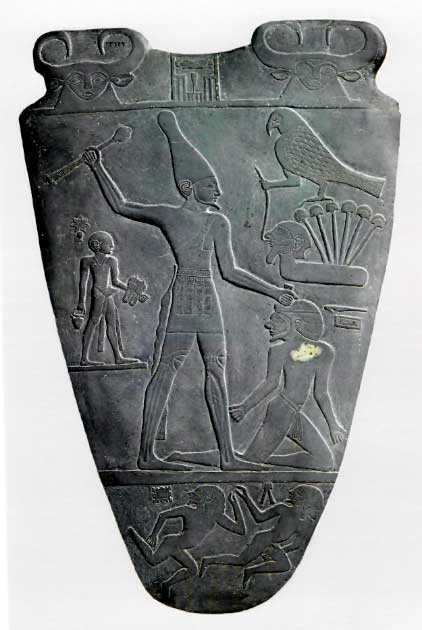
Depiction of Pharaoh Narmer, of the First Dynasty of Egypt (Heagy1 / CC BY SA 3.0)
In total, it is generally agreed that there were thirty four such dynasties in Egypt’s timeline, until it finally lapsed out of existence at the hands of the Roman Empire and later conquerors. Some were good, others were great, and yet others were simply bad. And each dynasty produced some truly legendary pharaohs. One dynasty that particularly found its spot in Egypt’s history was the Eighteenth Dynasty.
During the Eighteenth Dynasty, Egypt reached the zenith of its power and dominance in the region. It kept its enemies at bay and greatly expanded its influence. The rule of this dynasty began around 1550 BC and ended in 1292 BC. But why did such a powerful period come to an end? Well, it is often said that good and abundant ages produce increasingly worse rulers. The truth of that came around the time of the rise of Pharaoh Akhenaten, a powerful but eccentric leader who sought to entirely reform the age-old religion of his nation. Akhenaten introduced the worship of the sun, much to the anger of the people. Egypt became divided, restless, and weakened. The people were not ready for such major changes.
- The Great and Powerful Pharaoh, Ramses: The Battle of Kadesh, a Clash of Titans – Part I
- Pharaoh Akhenaten: An Alternative View of the Heretic King
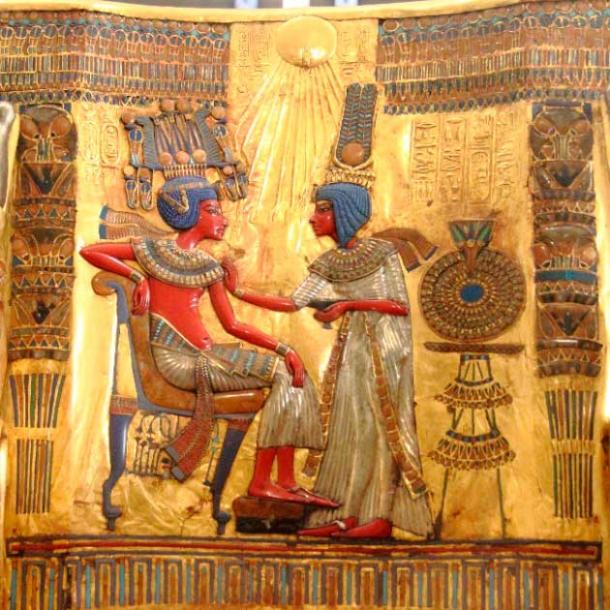
The Aten depicted in art as a sun disc, from the throne of Tutankhamun, perhaps originally made for Akhenaten. (Djehouty / CC BY SA 4.0)
Taking Hold of the Shattered Realm
When Akhenaten died, his heir and successor, Tutankhamun, tried his best to revert the radical changes of his father and put Egypt back into order. He was, however, a child weakened and deformed by generations of inbreeding, and his reign was relatively short. With no children to continue his lineage, Tutankhamun was succeeded by his close advisor - Kheperkheperure Ay. This man was the true power behind the crown, and he had great plans in continuing the ill-fated Eighteenth Dynasty. However, death cut his plans short, as he perished after only four years of rule.
- Mummy of Pharaoh Ramesses II Issued a Passport to Travel to France
- The Mysterious Disappearance of Nefertiti, Ruler of the Nile
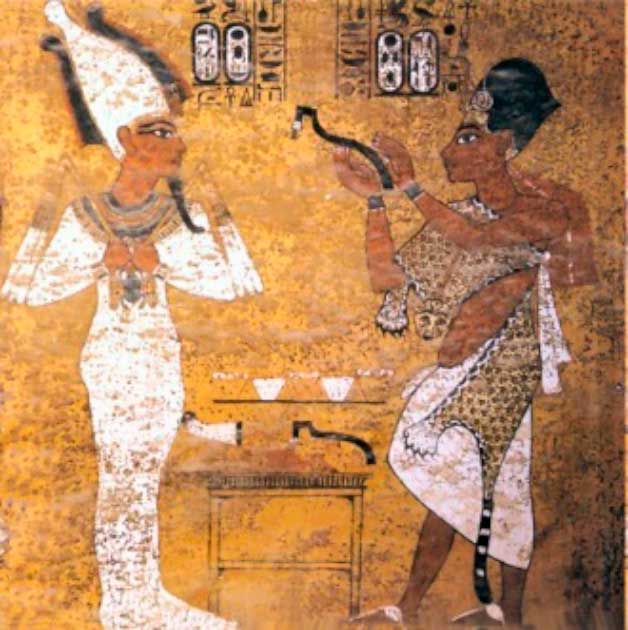
Ay performing the Opening of the Mouth ceremony at Tutankhamun. Wall painting from Tutankhamun's tomb (Public Domain)
In his place came a man of common birth, with no relation at all to the preceding royal dynasty. His name was Horemheb. Horemheb claimed the crown through marriage - his wife was one of Ay’s daughters. Although of common birth, this pharaoh excelled in his role. He brought together a divided state, stabilized it, and began a campaign of erasing the traces of his predecessors. He crushed the temples and statues of Akhenaten, repurposed the monuments of Ay and Tutankhamun, and slowly erased the memory of their religious reforms. He showed great power of judgment and the distinct ability to hold together a fragmented realm. Horemheb reigned for fourteen years, and everyone thought that the Eighteenth Dynasty would continue after him. But it was not so. The pharaoh had no surviving sons: in his stead, he appointed his close ally and vizier, Paramesse.
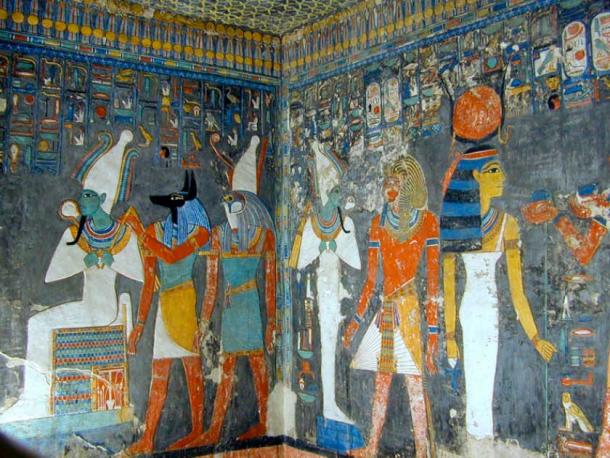
Wall friezes from the Tomb of Horemheb, final pharaoh of the Eighteenth Dynasty. King Horemheb with the Gods. On the left, Osiris, seated, Anubis at the head of a jackal and Horus, son of Isis at the head of a falcon. (Jean-Pierre Dalbera / CC BY 2.0)
Like his close friend and ally Horemheb, Paramesse was also not of royal birth. His family, however, was quite noble and prominent, and paved the way for his ascension to the post of vizier. And from vizier, he became pharaoh. Upon his arrival to the throne in 1292 BC, he adopted a regnal name: Menpehtyre Ramesses I, better known as Ramses I. And with that began the famed Nineteenth Dynasty, that of the Ramessids.
The Ramessid Dynasty: A Lineage of Great Pharoahs
With Ramses I, a new period of ancient Egyptian history began. It was the Ramesside Period, the reign of the powerful Nineteenth Dynasty, which arose from the terrible downfall of its predecessor. It was clear that Horemheb, having no heirs, chose his close ally Ramses with the fate of Egypt in mind. Ramses already had both a son and grandson, and that meant that the line of succession was secured with him, and the realm would not suffer. And that was true: Ramses was already in his old age when he became pharaoh, and had a son and grandson behind him. Because of this, his reign was brief; it lasted only one or two years, before death claimed him.
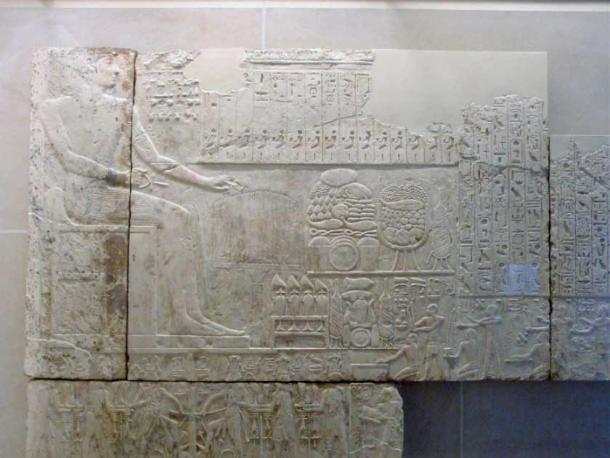
Reliefs from the Abydos chapel of Ramesses I which was built by Seti I, this king's son and successor to honor his father's memory. The finely cut chapel reliefs were presented by JP Morgan in 1911 to the Metropolitan Museum of New York where they are now on display. (John Campana / CC BY SA 2.0)
But there was no worry in the realm; his heir and successor had already been appointed. It was his son, Seti, who rose to the rank of pharaoh and took up the name Menmaatre Seti I. He too, even after some time had passed, had to remedy the ill effects of Akhenaten’s controversial reign. But he did it successfully, and reigned for roughly fifteen years as a powerful and dominant king. He consolidated the empire, and quickly began tackling the weakening dominance of Egypt in the region. He focused on reaffirming his power over Syria and Canaan, two historical regions that were now affected by the constant pressure from the neighboring Hittite Empire, one of the traditional enemies of Egypt. Due to this, Seti I conducted several strong military campaigns against the Hittites in the north, with good success. Most, if not all, of his campaigns ended as victories, or in favor of Egypt, but even so, he did not manage to break the power of the vast Hittite Empire. Still, he reconquered most of the territories that were affected, and reasserted Egypt’s domination to a large extent.
The memory of his great victories against the Hittites and others was preserved in stone, as was the Egyptian custom. Great and lavish bas-reliefs in stone adorned the front of the Temple of Amun in Karnak, displaying his glory and might for all to see. Historians agree that Seti was a great king with little flaws, and that his reign was a very successful one, especially after the turbulence of the Akhenaten era. It is certain that much of the success depended on Seti’s military exploits, which were directed chiefly against the Semitic-speaking peoples of the north and east. He defeated Libyan invaders and conquered and defeated many Hebrews.
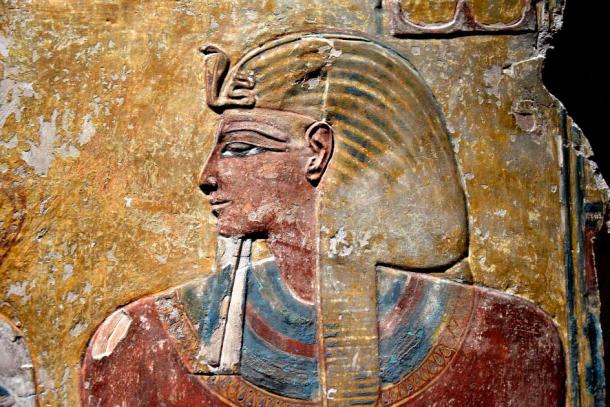
Pharaoh Seti I of the Ramessid Dynasty. Detail of a wall painting from the Tomb of Seti I, KV17, at the Valley of the Kings (Osama Shukir Muhammed Amin FRCP / CC BY SA 4.0)
The Ramessid Dynasty Brought Back Egypt’s Golden Age
One of Seti’s most renowned accomplishments was his capture of the border city of Kadesh, situated in Syria. There was great rivalry between Egypt and the Hittite Empire, centered on the town of Kadesh, and the Egyptians had lost control over it ever since Akhenaten. Now it was time to reconquer it, and Seti I took up the task. He led a great army into what is considered one of the earliest pitched battles in history. The Battle of Kadesh occurred in 1274 BC, and was the largest chariot battle ever fought, as it included some 6,000 war chariots in total. The battle was inconclusive, but Seti managed to triumphantly march into it as a sign of his triumph. However, he could not hold it permanently, and it soon once again reverted to Hittite control.
Seti died in 1279 BC, and was laid to rest in a lavish and exquisite burial tomb in the Valley of the Kings. It is the longest and deepest of all New Kingdom tombs, and is renowned for its wealth of carvings, inscriptions, and paintings. Every single chamber and passageway were adorned with scenes, more proof of Seti’s wealth, power, and grandeur.
However, all the grandeur and power of Seti would soon be overshadowed by his son and heir, Ramses II, who would become an even better pharaoh than his father was. Bearing the name of his grandfather, Ramses II gained the epithet “Great”, and is considered as “the greatest, most celebrated, and most powerful” pharaoh of the New Kingdom period, which is the golden era of ancient Egypt. In the entire ancient history of the world, Ramses II is remembered for his strength and power as one of Egypt’s most capable monarchs. In fact, he was so loved and admired, that all the subsequent pharaohs in history referred to him as “the Great Ancestor”, even though he lived centuries before some of them.
The first part of his rule was dedicated to the building of stunning temples, monuments, and even entire new cities. He built Pi-Ramesses, his new capital that lay in the Nile Delta, from which he would conduct his new military campaigns. And this he did as soon as possible: he aimed to reconquer territories previously lost to Hittites, Nubians, and the Libyan tribes. He penetrated deep into Nubia, Syria, and Canaan, laying waste to his enemies and keeping the borders of Egypt secure from the threats of Sea Peoples. Wherever threats arose, Ramses the Great dealt with them efficiently and decisively. And with that, he kept Egypt free to rise in its Golden Age.
From Great Monarchs to Lesser Leaders in the Ramessid Dynasty
The strength of ancient Egypt’s army peaked during the reign of Ramses II. It numbered some 100,000 men, which was an awe-inspiring number for such an ancient age. And it was this number that kept enemies at bay and solidified the influence of Egypt. Ramses the Great enjoyed a very long reign, and died sometime in his 90th or 91st year of life. He was succeeded by his 13th son, Merneptah, already an old man when he became pharaoh. His reign was rather uneventful when compared to his father or grandfather, and it lasted for no more than ten years. With his death, there began a gradual decline in the power and grandeur of the once-formidable Nineteenth Ramessid Dynasty.
Since Ramses the Great had “innumerable” sons, it was inevitable that some of them would try and usurp the Egyptian throne and interrupt the line of succession. This happened during the reign of Merneptah’s son, Seti II, when Egypt declined into brief chaos as rival heir Amenmesse usurped his position. After some four years of instability, Seti II regained his full position. However, he did not get to reign as long as his predecessors; he died after only six years as pharaoh. Further instability continued in the royal court; Seti’s chief advisor, an upstart named Chancellor Bay, pulled the strings and schemed, rising to great power. Formally, Seti II was succeeded by his son, Merneptah Siptah, and informally by his eldest wife, Queen Twosret.
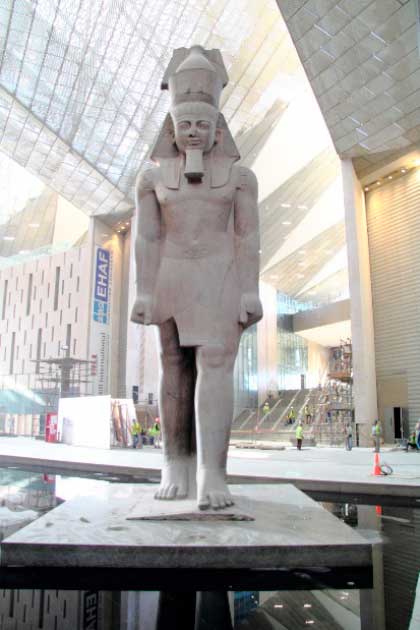
Statue of Ramesses II, also known as Ramses the Great of the Ramessid Dynasty, located in the entrance hall of the Grand Egyptian Museum during construction (Djehouty / CC BY SA 4.0)
The Final Decline and End of the Ramessid Dynasty
The success and power of the Nineteenth Dynasty of Egypt was, alas, very brief. Together, roughly eight monarchs of this era reigned for a collective 110 years, from around 1292 to 1187 BC. From their origins with Horemheb, they managed to rise up triumphantly from the chaos of Akhenaten’s reign, and to use the power vacuum to their own favor. Seti I and Ramses II excelled as vibrant, active, and dominant pharaohs, etching their name in ancient history as the very best of all of Egyptian pharaohs.
But if history teaches us something, it is that those that rise to great heights are bound to fall back down rather quickly. The pharaohs that followed these two great leaders were not able to fill the shoes of their forebears, and failed to consolidate their power and maintain the influence of the royal court.
Top Image: Aswan temple, completed by Ramses II of the Ramessid Dynasty. Source: Konstantin / Adobe Stock
References
Dalton, S. The Ancient Egyptian New Kingdom. Dttv Publications.
Frood, E. 2007. Biographical Texts from Ramessid Egypt. Society of Biblical Lit.
Sweeney, E. 2021. Egypt's Ramesside Pharaohs and the Persians. Algora Publishing.
















Comments
Was Akhenaten simply an "eccentric"?
Occultists tend to ridicule him just as they ridicule Jesus. There may well be a connection there, if both are historical figures in monotheistic religion that stood against Occultism.
It doesn't pay to upset the ruling religious orthodoxy. That, today, is Occultism, just as it was in Ancient Egypt at the time of Akhenaten, no matter how hard he may have tried to change it.
Thanks for the correction. I meant Luxor. Edited.
Nobody gets paid to tell the truth.
Thebes isn't Alexandria, it's about 200 kilometres away. Why does every article has to have a postscript from this loon? A triumph of complete ignorance over research every time!
“Plato tells us that Thebes (Luxor) was known for its tall blonde people.”
Please note there was, and is a Thebes in Greece, contemporary with the 18th Dynasty in Egypt and there are and were blonde people in Greece. Also note that the ancient Egyptians were diligent in portraying ethnicity in their art, particularly the battle scenes where it is easy to determine the origin and nationality of the opponents - which is the point of depicting such events. But even the documentation in reliefs and paintings of friendly or diplomatic visits depicts the counterparties accurately.
And yes, items from Tutankhamuns’s tomb have been carbon dated.
The entire story is probably a false narrative. I’m very sceptical of a lot of the Egyptian imagery. Plato tells us that Thebes (Luxor) was known for its tall blonde people. Of course, Plato also wrote about the destruction of Atlantis, where somebody had thought to remove a zero from his timeline, having the event occurring 11.5k BC vice 115 BC, when it makes sense that it certainly happened – to correlate with the sudden onset of ensuing Ice Age/nuclear winter.
And so they present imagery like this: https://www.ancient-origins.net/sites/default/files/styles/large/public/... ["sun disc from the throne of Tutankhamun, perhaps originally made for Akhenaten"] Has anyone carbon dated this to see if the paint/pigment, which looks to be in too-good condition, matches up with confirmed radiometric dating other era pieces. OBVIOUSLY we need to ensure no much-later ‘artistic representations’. This is just normal, due diligence, beyond the question of why ancient Egyptians, who like the ancient Greeks were golden-haired (per Plato) and celebrated golden-haired people/gods, ...why would they portray themselves consistently as brown-skinned and blue-haired? Of course, deception is a huge part of history, and the rewriting or portrayal of false imagery and narrative is epic and endemic. Note all the Aryan-type/upward noses that have been smashed off, probably by a later Semitic people who looked differently and had a disdain for what that look represented. Further, they never live-stream when they access new caverns or deep rubble heaps where impressive works are found until AFTER those works are READY to present to the public. So here we go again, a lot of tampering to effectively eliminate the idea of a fair-haired, Atlantean-era people and culture wiped out and supplanted, violently, with a distinct, dark-haired new stock of people (black-headed, Sumerian/Persian) coming in later to resettle the ruins, and claim all as their own, and lay down layers of deception to cover up the truth of it?
Nobody gets paid to tell the truth.